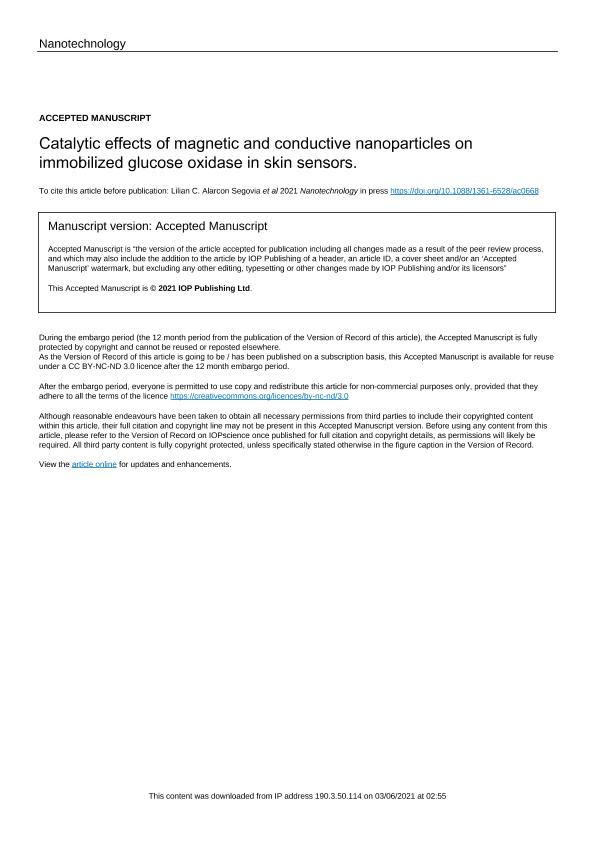Artículo
Catalytic effects of magnetic and conductive nanoparticles on immobilized glucose oxidase in skin sensors
Fecha de publicación:
21/06/2021
Editorial:
IOP Publishing
Revista:
Nanotechnology
ISSN:
0957-4484
Idioma:
Inglés
Tipo de recurso:
Artículo publicado
Clasificación temática:
Resumen
Wearable skin sensors is a promising technology for real-time health care monitoring. They are of particular interest for monitoring glucose in diabetic patients. The concentration of glucose in sweat can be more than two orders of magnitude lower than in blood. In consequence, the scientific and technological efforts are focused in developing new concepts to enhance the sensitivity, decrease the limit of detection (LOD) and reduce the response time (RT) of glucose skin sensors. This work explores the effect of adsorbed superparamagnetic magnetite nanoparticles (MNPs) and conductive nanoparticles (CNPs) on carbon nanotube substrates (CNTs) used to immobilize glucose oxidase enzyme in the working electrode of skin sensors. MNPs and CNPs are made of magnetite and gold, respectively. The performance of the sensors was tested in standard buffer solution, artificial sweat, fresh sweat and on the skin of a healthy volunteer during an exercise session. In the case of artificial sweat, the presence of MNPs accelerated the RT from 7 to 5 s at the expense of increasing the LOD from 0.017 to 0.022 mM with slight increase of the sensitivity from 4.90 to 5.09 μAm M-1 cm-2. The presence of CNPs greatly accelerated the RT from 7 to 2 s and lowered the LOD from 0.017 to 0.014 mM at the expense of a great diminution of the sensitivity from 4.90 to 4.09 μAm M-1 cm-2. These effects were explained mechanistically by analyzing the changes in the concentration of free oxygen and electrons promoted by MNPs and CNPs in the CNTs and its consequences on the the glucose oxidation process.
Archivos asociados
Licencia
Identificadores
Colecciones
Articulos(IMAL)
Articulos de INST.DE MATEMATICA APLICADA "LITORAL"
Articulos de INST.DE MATEMATICA APLICADA "LITORAL"
Citación
Alarcon Segovia, Lilian Celeste; Bandodkar, Amay J.; Rogers, John A.; Rintoul, Ignacio; Catalytic effects of magnetic and conductive nanoparticles on immobilized glucose oxidase in skin sensors; IOP Publishing; Nanotechnology; 32; 37; 21-6-2021; 1-22
Compartir
Altmétricas




